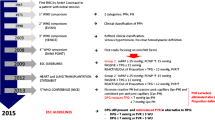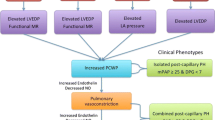Abstract
Objective
Pulmonary hypertension (PH) due to left ventricular systolic dysfunction (PH-HFrEF) is a common heart disease with poor prognosis. In this study, we explored the risk factors for PH-HFrEF and investigated the related factors affecting the prognosis of PH-HFrEF patients.
Methods
The study recruited consecutive patients with PH-HFrEF and systolic pulmonary artery pressure (sPAP) of more than 40 mm Hg with left ventricular ejection fraction (LVEF) of less than 45% on echocardiography. Patients with left ventricular systolic dysfunction (HFrEF) but without PH (sPAP < 30 mmHg and LVEF < 45%) were chosen as the control group. Patients were followed up for 18 months, and major adverse cardiac events (MACE) were recorded.
Results
In total, 93 patients with PH-HFrEF formed the study group and 93 LVEF-matched patients with HFrEF were enrolled as controls. Body mass index (BMI) in PH-HFrEF patients was significantly lower compared with the control group (p < 0.05). Multivariate logistic regression analysis revealed that low BMI was an independent predictor of the presence of PH in patients with HFrEF (p < 0.05). There were 23 (24.7%) MACE in the PH-HFrEF group and 18 (19.4%) MACE in the control group. Cox regression analysis showed that low BMI was an independent predictor of MACE occurrence in the PH-HFrEF group (p < 0.05).
Conclusion
Low BMI appear to be significantly associated with PH occurrence in patients with HFrEF, and is an independent predictor of MACE in patients with PH-HFrEF.
Zusammenfassung
Ziel
Die pulmonale Hypertonie (PH) aufgrund linksventrikulärer systolischer Dysfunktion (PH-HFrEF) stellt eine häufige Herzerkrankung mit ungünstiger Prognose dar. In der vorliegenden Studie wurden die Risikofaktoren für eine PH-HFrEF und die entsprechenden Faktoren mit Einfluss auf die Prognose von PH-HFrEF-Patienten untersucht.
Methoden
Für die Studie wurden konsekutiv Patienten mit PH-HFrEF und systolischem pulmonalarteriellem Druck (sPAP) von mehr als 40 mm Hg mit linksventrikulärer Ejektionsfraktion (LVEF) von weniger als 45% in der Echokardiographie rekrutiert. Patienten mit linksventrikulärer systolischer Dysfunktion (HFrEF), aber ohne PH (sPAP < 30 mm Hg und LVEF < 45%) wurden als Kontrollgruppe ausgewählt. Die Patienten wurden 18 Monate lang nachbeobachtet, dabei wurden schwere ungünstige kardiale Ereignisse („major adverse cardiac events“, MACE) dokumentiert.
Ergebnisse
Insgesamt bildeten 93 Patienten mit PH-HFrEF die Studiengruppe und 93 LVEF-gematchte Patienten mit HFrEF die Kontrollgruppe. Der Body-Mass-Index (BMI) bei den PH-HFrEF-Patienten war signifikant niedriger als in der Kontrollgruppe (p < 0,05). Die multivariate logistische Regressionsanalyse ergab, dass ein niedriger BMI ein unabhängiger Prädiktor für das Vorliegen einer PH bei Patienten mit HFrEF (p < 0,05) war. Es gab 23 (24,7%) MACE in der PH-HFrEF-Gruppe und 18 (19,4%) MACE in der Kontrollgruppe. In der Cox-Regressionsanalyse zeigte sich, dass ein niedriger BMI ein unabhängiger Prädiktor für das Auftreten von MACE in der PH-HFrEF-Gruppe war (p < 0,05).
Schlussfolgerung
Ein niedriger BMI scheint signifikant mit dem Vorliegen einer PH bei Patienten mit HFrEF assoziiert zu sein und stellt einen unabhängigen Prädiktor für das Auftreten von MACE bei Patienten mit PH-HFrEF dar.
Similar content being viewed by others
References
Galiè N, Humbert M, Vachiery JL, Gibbs S, Lang I, Torbicki A et al (2016) 2015 ESC/ERS guidelines for the diagnosis and treatment of pulmonary hypertension: the joint task force for the diagnosis and treatment of pulmonary hypertension of the European society of cardiology (ESC) and the European respiratory society (ERS): endorsed by: association for European paediatric and congenital cardiology (AEPC), international society for heart and lung transplantation (ISHLT). Eur Heart J 37:67–119
Oudiz RJ (2007) Pulmonary hypertension associated with left-sided heart disease. Clin Chest Med 28:233–241
Schmeisser A, Schroetter H, Braun-Dulleaus RC (2013) Management of pulmonary hypertension in left heart disease. Ther Adv Cardiovasc Dis 7:131–151
Farber HW, Gibbs S (2015) Under pressure: pulmonary hypertension associated with left heart disease. Eur Respir Rev 24:665–673
Oudiz RJ (2007) Pulmonary hypertension associated with left-sided heart disease. Clin Chest Med 28:233–2341
Soubrier F, Chung WK, Machado R, Grünig E, Aldred M, Geraci M et al (2013) Genetics and genomics of pulmonary arterial hypertension. J Am Coll Cardiol 62(25):D13–21
Lang RM, Bierig M, Devereux RB, Flachskampf FA, Foster E, Pellikka PA et al (2005) Recommendations for chamber quantification: a report from the American society of echocardiography’s guidelines and standards committee and the chamber quantification writing group, developed in conjunction with the European association of echocardiography, a branch of the European society of cardiology. J Am Soc Echocardiogr 18:1440–1463
Ommen SR, Nishimura RA, Hurrell DG, Klarich KW (2000) Assessment of right atrial pressure with 2‑dimensional and Doppler echocardiography: a simultaneous catheterization and echocardiographic study. Mayo Clin Proc 75:24–29
Yancy CW, Jessup M, Bozkurt B, Butler J, Casey DE Jr, Colvin M et al (2017) 2017 ACC/AHA/HFSA focused update of the 2013 ACCF/AHA guideline for the management of heart failure: a report of the American college of cardiology/American heart association task force on clinical practice guidelines and the heart failure society of america. J Am Coll Cardiol 70:776–803
Badesch DB, Champion HC, Sanchez MA, Hoeper MM, Loyd JE, Manes A et al (2009) Diagnosis and assessment of pulmonary arterial hypertension. J Am Coll Cardiol 54(1):S55–66
Vahanian A, Alfieri O, Andreotti F, Antunes MJ, Barón-Esquivias G, Baumgartner H et al (2012) Guidelines on the management of valvular heart disease (version 2012). Eur Heart J 33:2451–2496
Shindler DM, Kostis JB, Yusuf S, Quinones MA, Pitt B, Stewart D et al (1996) Diabetes mellitus, a predictor of morbidity and mortality in the studies of left ventricular dysfunction (SOLVD) trials and registry. Am J Cardiol 77:1017–1020
Dauriz M, Targher G, Laroche C, Temporelli PL, Ferrari R, Anker S et al (2017) Association between diabetes and 1‑year adverse clinical outcomes in a multinational cohort of ambulatory patients with chronic heart failure: results from the ESC-HFA heart failure long-term registry. Diabetes Care 40:671–678
Varga ZV, Giricz Z, Liaudet L, Hasko G, Ferdinandy P, Pacher P et al (2015) Interplay of oxidative, nitrosative/nitrative stress, inflammation, cell death and autophagy in diabetic cardiomyopathy. Biochim Biophys Acta 1852:232–242
Schmieder RE, Hilgers KF, Schlaich MP, Schmidt BM (2007) Renin-angiotensin system and cardiovascular risk. Lancet 369:1208–1219
Kumar R, Yong QC, Thomas CM, Baker KM (2012) Intracardiac intracellular angiotensin system in diabetes. Am J Physiol Regul Integr Comp Physiol 302:R510–517
Connelly KA, Kelly DJ, Zhang Y, Prior DL, Advani A, Cox AJ et al (2009) Inhibition of protein kinase C‑beta by ruboxistaurin preserves cardiac function and reduces extracellular matrix production in diabetic cardiomyopathy. Circ Heart Fail 2:129–137
Latha R, Shanthi P, Sachdanandam P (2013) Kalpaamruthaa modulates oxidative stress in cardiovascular complication associated with type 2 diabetes mellitus through PKC-β/Akt signaling. Can J Physiol Pharmacol 91:901–912
Ishikawa T, Kajiwara H, Kurihara S (1999) Alterations in contractile properties and Ca2+ handling in streptozotocin-induced diabetic rat myocardium. Am J Physiol 277:H2185–2194
Movahed MR, Hashemzadeh M, Jamal MM (2005) The prevalence of pulmonary embolism and pulmonary hypertension in patients with type II diabetes mellitus. Chest 128:3568–3571
Whitaker ME, Nair V, Sinari S, Dherange PA, Natarajan B, Trutter L et al (2018) Diabetes mellitus associates with increased right ventricular afterload and remodeling in pulmonary arterial hypertension. Am J Med 131:702.e7–702.e13
Habbu A, Lakkis NM, Dokainish H (2006) The obesity paradox: fact or fiction? Am J Cardiol 98:944–948
Fonarow GC, Srikanthan P, Costanzo MR, Cintron GB, Lopatin M (2007) Adhere scientific advisory committee and investigators. An obesity paradox in acute heart failure: analysis of body mass index and inhospital mortality for 108,927 patients in the acute decompensated heart failure national registry. Am Heart J 153:74–81
Christenson RH, Azzazy HM, Duh SH, Maynard S, Seliger SL, Defilippi CR (2010) Impact of increased body mass index on accuracy of B‑type natriuretic peptide (BNP) and N‑terminal proBNP for diagnosis of decompensated heart failure and prediction of all-cause mortality. Clin Chem 56:633–641
Yoshihisa A, Sato T, Kajimoto K, Sato N, Takeishi Y, Acute Decompensated Heart Failure Syndromes (ATTEND) investigators (2017) Heterogeneous impact of body mass index on in-hospital mortality in acute heart failure syndromes: an analysis from the ATTEND registry. Eur Heart J Acute Cardiovasc Care. https://doi.org/10.1177/2048872617703061
Zeng WJ, Sun YJ, Gu Q, Xiong CM, Li JJ, He JG (2012) Impact of sildenafil on survival of patients with idiopathic pulmonary arterial hypertension. J Clin Pharmacol 52:1357–1364
Zeng WJ, Sun YJ, Gu Q, Xiong CM, Li JJ, He JG (2012) The impact of pulmonary arterial hypertension-targeted therapy on survival in Chinese patients with idiopathic pulmonary arterial hypertension. Pulm Circ 2:373–378
Hu EC, He JG, Liu ZH, Ni XH, Zheng YG, Gu Q et al (2014) Survival advantages of excess body mass index in patients with idiopathic pulmonary arterial hypertension. Acta Cardiol 69:673–678
Takiguchi M, Yoshihisa A, Miura S, Shimizu T, Nakamura Y, Yamauchi H et al (2014) Impact of body mass index on mortality in heart failure patients. Eur J Clin Invest 44:1197–1205
Acknowledgements
This study was supported by the Suzhou Science and Technology Development Program Guidance Project Fund (grant number SYSD2013093), the Youth Natural Science Fund of Soochow University (grant number SDY2013A32), the Research Fund of the Second Affiliated Hospital of Soochow University (grant number SDFEYGJ1405), and the Xinxin Heart (SIP) Foundation (2019-CCA-ACCESS-058). The authors gratefully acknowledge the assistance of Dr. Xinyi Zhu, Miss Yan-Ni Wu, and Miss Jing Zhu with patient recruitment. The authors would like to thank the participants and their families for participating in this study.
Author information
Authors and Affiliations
Contributions
LPZ and LW participated in the study design. YC participated data analysis. XC, FJ and XL participated in acquisition of data and interpretation of the results. LPZ and LW contributed to writing and revising the manuscript. All authors read and approved the final manuscript.
Corresponding author
Ethics declarations
Conflict of interest
L. Wang, L.-P. Zhao, Y. Chen, X. Chang, F. Jin, and X. Liu declare that they have no competing interests.
For this article no studies with human participants or animals were performed by any of the authors. All studies performed were in accordance with the ethical standards indicated in each case.
Rights and permissions
About this article
Cite this article
Wang, L., Zhao, LP., Chen, Y. et al. Obesity paradox in pulmonary hypertension due to left ventricular systolic dysfunction. Herz 46, 575–580 (2021). https://doi.org/10.1007/s00059-021-05023-4
Received:
Revised:
Accepted:
Published:
Issue Date:
DOI: https://doi.org/10.1007/s00059-021-05023-4




